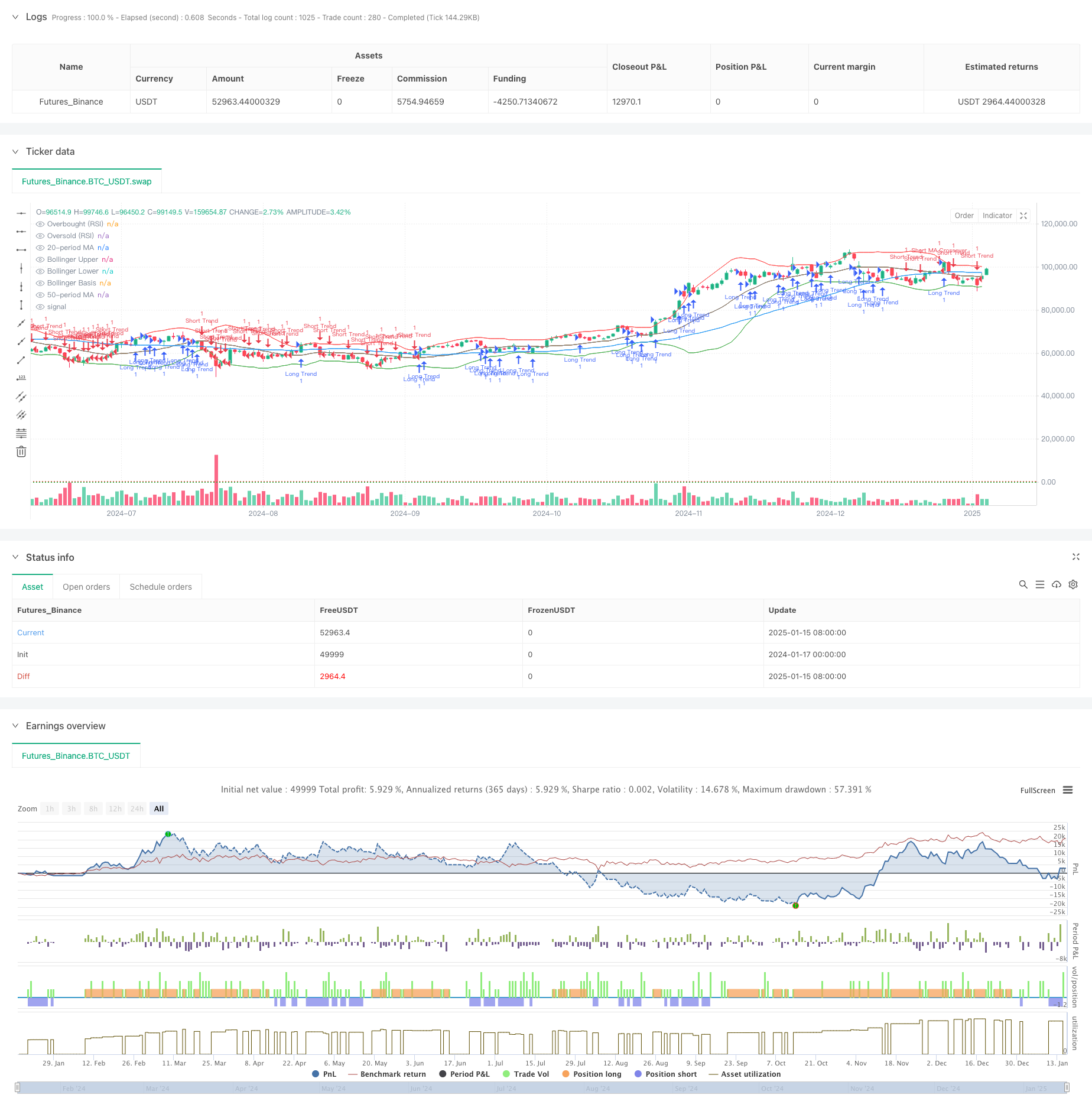
概述
该策略是一个融合多重技术分析指标的自适应交易系统,通过动态识别市场状态来切换不同的交易策略。系统主要基于移动平均线(MA)、布林带(BB)和相对强弱指标(RSI)三大技术指标,根据市场趋势和区间震荡特征自动选择最适合的交易方式。策略通过设定不同的止盈止损参数,针对趋势和区间市场采用差异化的风险管理方案。
策略原理
策略通过50期和20期两条移动平均线来判断市场趋势,结合布林带和RSI指标来识别超买超卖区域。在趋势市场中,系统主要依据价格与慢速移动平均线的关系以及快慢线交叉来进行交易;在区间市场中,则主要依据布林带边界突破和RSI超买超卖信号进行交易。系统根据市场环境自动调整止盈水平,趋势行情采用6%止盈,区间行情采用4%止盈,统一使用2%止损来控制风险。
策略优势
- 市场适应性强:能够根据不同市场环境自动切换交易策略,提高系统的稳定性
- 风险管理完善:对趋势和区间行情采用不同的止盈比例,更符合市场特征
- 信号多维验证:通过多个技术指标交叉验证,提高交易信号的可靠性
- 自动化程度高:全程自动化操作,无需人工干预,降低主观判断带来的误差
策略风险
- 参数敏感性:多个技术指标参数的选择会影响策略表现,需要经过充分的参数优化
- 市场切换滞后:市场状态的判断可能存在滞后性,影响策略表现
- 假信号风险:在剧烈波动市场中可能产生虚假交易信号
- 交易成本考量:频繁的策略切换可能带来较高的交易成本
策略优化方向
- 引入成交量指标:在现有技术指标基础上增加成交量分析,提高信号可靠性
- 优化市场状态判断:可以考虑引入ATR、ADX等趋势强度指标,提高市场状态判断的准确性
- 动态参数调整:根据市场波动率自动调整止盈止损参数,提高策略适应性
- 增加过滤机制:设计更严格的交易条件,减少虚假信号
总结
该策略通过融合多个经典技术指标,构建了一个能够适应不同市场环境的自适应交易系统。系统在保持操作简单的同时,实现了市场状态的动态识别和交易策略的自动切换,具有较强的实用性。通过差异化的止盈止损设置,策略在控制风险的同时保持了较好的盈利能力。后续可以通过引入更多技术指标和优化参数调整机制来进一步提升策略的稳定性和可靠性。
策略源码
/*backtest
start: 2024-01-17 00:00:00
end: 2025-01-16 00:00:00
period: 1d
basePeriod: 1d
exchanges: [{"eid":"Futures_Binance","currency":"BTC_USDT","balance":49999}]
*/
//@version=6
strategy("Supply & Demand Test 1 - Enhanced", overlay=true)
// Inputs
ma_length = input.int(50, title="50-period Moving Average Length", minval=1)
ma_length_fast = input.int(20, title="20-period Moving Average Length", minval=1)
bb_length = input.int(20, title="Bollinger Bands Length", minval=1)
bb_std_dev = input.float(2.0, title="Bollinger Bands Std Dev", step=0.1)
rsi_length = input.int(14, title="RSI Length", minval=1)
stop_loss_percent = input.float(0.02, title="Stop Loss Percent", step=0.001, minval=0.001)
take_profit_trend = input.float(0.06, title="Take Profit Percent (Trend)", step=0.001, minval=0.001)
take_profit_range = input.float(0.04, title="Take Profit Percent (Range)", step=0.001, minval=0.001)
// Moving Averages
ma_slow = ta.sma(close, ma_length)
ma_fast = ta.sma(close, ma_length_fast)
// Bollinger Bands
bb_basis = ta.sma(close, bb_length)
bb_dev = ta.stdev(close, bb_length)
bb_upper = bb_basis + bb_std_dev * bb_dev
bb_lower = bb_basis - bb_std_dev * bb_dev
// RSI
rsi = ta.rsi(close, rsi_length)
// Market Conditions
is_trending_up = close > ma_slow
is_trending_down = close < ma_slow
is_range_bound = not (is_trending_up or is_trending_down)
// Entry Conditions
long_trend_entry = is_trending_up and close >= ma_slow * 1.02
short_trend_entry = is_trending_down and close <= ma_slow * 0.98
long_ma_crossover = ta.crossover(ma_fast, ma_slow)
short_ma_crossover = ta.crossunder(ma_fast, ma_slow)
long_range_entry = is_range_bound and close <= bb_lower * 0.97
short_range_entry = is_range_bound and close >= bb_upper * 1.03
long_rsi_entry = is_range_bound and rsi < 30
short_rsi_entry = is_range_bound and rsi > 70
// Entry and Exit Logic
if long_trend_entry
strategy.entry("Long Trend", strategy.long)
strategy.exit("Exit Long Trend", from_entry="Long Trend", stop=close * (1 - stop_loss_percent), limit=close * (1 + take_profit_trend))
alert("Entered Long Trend", alert.freq_once_per_bar)
if short_trend_entry
strategy.entry("Short Trend", strategy.short)
strategy.exit("Exit Short Trend", from_entry="Short Trend", stop=close * (1 + stop_loss_percent), limit=close * (1 - take_profit_trend))
alert("Entered Short Trend", alert.freq_once_per_bar)
if long_ma_crossover
strategy.entry("Long MA Crossover", strategy.long)
strategy.exit("Exit Long MA Crossover", from_entry="Long MA Crossover", stop=close * (1 - stop_loss_percent), limit=close * (1 + take_profit_trend))
alert("Entered Long MA Crossover", alert.freq_once_per_bar)
if short_ma_crossover
strategy.entry("Short MA Crossover", strategy.short)
strategy.exit("Exit Short MA Crossover", from_entry="Short MA Crossover", stop=close * (1 + stop_loss_percent), limit=close * (1 - take_profit_trend))
alert("Entered Short MA Crossover", alert.freq_once_per_bar)
if long_range_entry
strategy.entry("Long Range", strategy.long)
strategy.exit("Exit Long Range", from_entry="Long Range", stop=close * (1 - stop_loss_percent), limit=close * (1 + take_profit_range))
alert("Entered Long Range", alert.freq_once_per_bar)
if short_range_entry
strategy.entry("Short Range", strategy.short)
strategy.exit("Exit Short Range", from_entry="Short Range", stop=close * (1 + stop_loss_percent), limit=close * (1 - take_profit_range))
alert("Entered Short Range", alert.freq_once_per_bar)
if long_rsi_entry
strategy.entry("Long RSI", strategy.long)
strategy.exit("Exit Long RSI", from_entry="Long RSI", stop=close * (1 - stop_loss_percent), limit=close * (1 + take_profit_range))
alert("Entered Long RSI", alert.freq_once_per_bar)
if short_rsi_entry
strategy.entry("Short RSI", strategy.short)
strategy.exit("Exit Short RSI", from_entry="Short RSI", stop=close * (1 + stop_loss_percent), limit=close * (1 - take_profit_range))
alert("Entered Short RSI", alert.freq_once_per_bar)
// Plotting
plot(ma_slow, color=color.blue, title="50-period MA")
plot(ma_fast, color=color.orange, title="20-period MA")
plot(bb_upper, color=color.red, title="Bollinger Upper")
plot(bb_lower, color=color.green, title="Bollinger Lower")
plot(bb_basis, color=color.gray, title="Bollinger Basis")
hline(70, "Overbought (RSI)", color=color.red, linestyle=hline.style_dotted)
hline(30, "Oversold (RSI)", color=color.green, linestyle=hline.style_dotted)
相关推荐